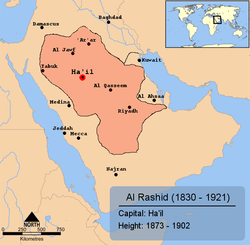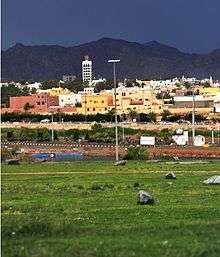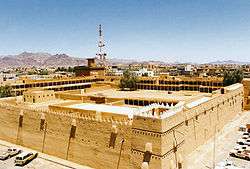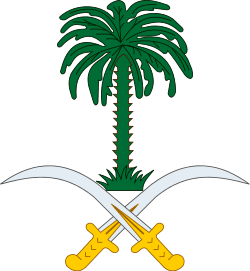Ha'il
| Ha'il City حائل | ||
|---|---|---|
|
Qishlah Palace in Ha'il | ||
| ||
 Ha'il City Location of Ha'il | ||
| Coordinates: 27°31′N 41°41′E / 27.517°N 41.683°ECoordinates: 27°31′N 41°41′E / 27.517°N 41.683°E | ||
| Country |
| |
| Province | Ha'il | |
| Government | ||
| • Governor | Saud bin Abdul Muhsin Al Saud | |
| • Deputy Governor | Prince Sa`ad bin Abdulaziz | |
| • Mayor | Ibrahim Aburas | |
| Elevation | 992 m (3,255 ft) | |
| Population (2002 census) | ||
| • Total | 412,758 | |
| Area code(s) | (+966) 016 | |
| Website |
www | |
Ha'il (Arabic: حائل Ḥā'il), also spelled Hail, Ha'yel, or Hayil, is a city in north-western Saudi Arabia. It is the capital of the Ha'il Province. The city has a population of 412,758 according to Ha'il Province.
Ha'il City is largely agricultural, with significant grain, date, and fruit production. A large percentage of the kingdom's wheat production comes from Ha'il Province, where the area to the northeast, 60 to 100 km (37 to 62 miles) away, consists of irrigated gardens. Historically Ha'il derived its wealth from being on the camel caravan route of the Hajj. Ha'il is well known by the generosity of its people in Saudi Arabia and the Arab world as it is the place where Hatim al-Tai lived. It is also the homeland of the Al Rashid family, historical rivals to the Al-Sauds.[1]
History
Ha'il City was the center of the emirate of Ha'il, a clan of the Shammar tribe, from 1836 until 1921. The first emir, Abdullah bin Rashid, took power with his brother emir Obaid and Jabbr's sons. Abdullah bin Rashid continued constructing the Barzan Palace in Ha'il which had been started by Mohammad Ibn Ali. After the death of Abdullah bin Rashid (in 1847 or 1848) his son and successor, Talal (or Telal), completed the palace.
During the Al Rashid period many foreign travelers visited Ha'il and the Rashidi emirs, and described their impressions in different journals and books, including those of Georg August Wallin (1854), William Gifford Palgrave (1865), Lady Anne Blunt (1881), Charles Montagu Doughty (1888), and Gertrude Bell (1914).
Al Rashid emirs were considered relatively tolerant towards foreigners, including traders in Ha'il:
| “ | Many of these traders belonged to the Shiyaa sect, hated by some Sonnites, doubly hated by the Wahabees. But Telal affected not to perceive their religious discrepancies, and silenced all murmurs by marks of special favor towards these very dissenters, and also by the advantages which their presence was not long in procuring for the town.[2] | ” |

The opening of the Hejaz railway between Damascus and Medina, together with new inexpensive steamship routes to Jeddah, undermined the traditional camel caravan economy of Ha'il.[3]
The last Al Rashid emir was ousted from power by Ibn Saud of Saudi Arabia in 1921. Ibn Saud then gave orders to destroy the Barzan Palace and also ordered Al Rashid and Al Sabhan leaders to move from Ha'il to Riyadh City, and he assigned one person from the mentioned families, as temporary emir "Prince Ibraheem bin Salem Al Sabhan" in order to assure the loyalty from the Ha'il people and Shammar.
After this, Ha'il fell into steep decline, as witnessed by E. Rutter in 1931:
| “ | Hail seems like a city marooned among the sand...the population of Hail was plainly in decline. Numbers of houses in the northern quarter of the town were in ruins...many people of Hail had fled to the comfortable realms of King Faisal of Iraq... | ” |
Today Ha'il City is the center of Saudi Arabia's agricultural program, and most of the wheat crops of the kingdom come from the area surrounding the city. There are also a number of camel farms for the production of camel milk near the city.

Famous people
- Hatim al-Tai:
Was a famous pre-Islamic (Jahiliyyah) Arabian poet, and the father of the Sahaba Adi ibn Hatim and Safana bint Hatem. He was a Christian,[4] and belonged to the Ta'i Arabian tribe. Stories about his extreme generosity have made him an icon to Arabs up till the present day, as in the proverbial phrase "more generous than Hatem". There is a hill overlooking the city of Hail which has a reproduction of the campfire he lit to welcome his guests, which is turned on every night and can be seen from the center of the town. He was the ruler of his tribe. Then his son Aoudi became the ruler after his father's death he also became a Muslim in 628 after a meeting with the Prophet Mohammed.
- Abdulaziz bin Mitab:
The son of the third amir of Al Rashid, he was adopted by his uncle Mohammed, the fifth amir, and brought up to be his heir. After Mohammed died of natural causes, Abdulaziz succeeded him unopposed. However, the Rashidi rule was insecure, as their Ottoman allies were unpopular and weakening. In 1904 the young Ibn Saud, the founder of Saudi Arabia, returned from exile with a small force and retook Riyadh. Abdulaziz died in the battle of Rawdat Muhanna with Ibn Saud in 1906.
- Madawi Al-Rasheed:
A Saudi-Arabian-born professor of Social Anthropology at the department of Theology and Religious Studies in King's College London since 1994. She gives occasional lectures in the United States, Europe and the Middle East. She is working on religio-political debate in Saudi Arabia after 11 September. She has written several books and articles in academic journals on the Arabian Peninsula, Arab migration, globalization and religious trans-nationalism.
- Mohamed Al-Deayea:
A Saudi Arabian football (soccer) goalkeeper. He played in four World Cups for the Saudi Arabia national team, and as of early 2007, he is the world record holder for most international appearances by a male footballer, with 181 caps for Saudi Arabia. He is the current captain of local club Al Hilal.
Geography
- As Samra Mountain or Samra Mountain overlooks the city. This is where Hatim al-Tai lit a fire on the summit to welcome guests. Today an asphalted road goes to the summit where a natural gas-powered fire is lit at night. There is a park with a lake at the bottom of the mountain, and on the side of the mountain is the Emblem of Saudi Arabia (date palm and crossed swords) made from electric lights which are turned on at night. From the top of the mountain is a beautiful view of the city.
- Aja Mountain (Jebel Aja) is on the opposite side of Ha'il city from As-Samra. A huge Saudi flag made of electric lights, turned on at night, is located on the side of the mountain.
- The Adayra Valley runs roughly along a north-south axis, dividing central Ha'il in two.
Climate
Hail has a continental desert climate with hot summers and cool winters. It has a somewhat milder climate than other Saudi cities due to its higher altitude.
| Climate data for Hail, Saudi Arabia | |||||||||||||
|---|---|---|---|---|---|---|---|---|---|---|---|---|---|
| Month | Jan | Feb | Mar | Apr | May | Jun | Jul | Aug | Sep | Oct | Nov | Dec | Year |
| Record high °C (°F) | 27 (81) |
29 (84) |
34 (93) |
37 (99) |
42 (108) |
44 (111) |
44 (111) |
45 (113) |
42 (108) |
38 (100) |
31 (88) |
28 (82) |
45 (113) |
| Average high °C (°F) | 15.9 (60.6) |
19 (66) |
23.2 (73.8) |
27.9 (82.2) |
33.2 (91.8) |
37.3 (99.1) |
37.7 (99.9) |
38 (100) |
36.3 (97.3) |
31.5 (88.7) |
23.3 (73.9) |
17.2 (63) |
28.38 (83.03) |
| Average low °C (°F) | 3 (37) |
4.6 (40.3) |
8.4 (47.1) |
12.7 (54.9) |
18 (64) |
21.1 (70) |
22.5 (72.5) |
22 (72) |
16 (61) |
12 (54) |
10 (50) |
5 (41) |
12.94 (55.32) |
| Record low °C (°F) | −10 (14) |
−7 (19) |
−4 (25) |
0 (32) |
10 (50) |
16 (61) |
17 (63) |
16 (61) |
14 (57) |
5 (41) |
0 (32) |
−6 (21) |
−10 (14) |
| Average precipitation mm (inches) | 20.8 (0.819) |
19.1 (0.752) |
21.4 (0.843) |
27.6 (1.087) |
15.5 (0.61) |
0 (0) |
0 (0) |
0 (0) |
5.4 (0.213) |
12.9 (0.508) |
50.6 (1.992) |
12.3 (0.484) |
185.6 (7.308) |
| Source: Weather Reports | |||||||||||||
Sights
- Barzan Market is in the place where many years ago stood the Barzan Palace of the Al Rashid extended family who governed the area around Ha'il.
- Friday Market is a traditional-style souk, held on Friday because it is a national weekend.
- Garden Mall is the largest shopping mall in Hail,it has shops like lifestyle,shoe mart,babyshop,H&M,giordano,iconic etc. "Samah Center" became the second largest shopping center in Ha'il. The third being the "Hyper panda" shopping mall.
- Barzan Palace was a historic palace that used to be located in Ha'il up until the 1920s. It was built in 1808 by Prince Muhammad bin Abdul-Muhsin Al Ali over an area of more than 300,000 square meters. The Palace was completed during the rule of the 2nd Rashidi amir, Talal Ibn Abdullah (1848–68). The Palace consisted of 3 floors, the first had the reception halls, gardens, and kitchens. The second had the diplomatic guest rooms. The third had the royal family rooms. It was near Barzan Market. Main article: Barzan palace
- Airif Fort (also spelled Oreif) is on a hill on the edge of the city. It is a mud-brick (adobe) fort built over 200 years ago as a combined observation post and stronghold. There is a beautiful view of the city from the main watchtower.
- Qishlah Fortress, (also spelled Qashalah) Fortress, is an impressive sight located in the center of Ha'il. The current building was built in the 1940s while prince Abdul-Aziz bin Musa'ad Al Saud held office in Ha'il province. It is the largest traditional mud-brick fortress in Ha'il and is very well restored and preserved both outside and inside. It was used mostly as a barracks. Its two floors are 142.8x141.2 meters high, its walls are 8.5m high, and it has eight large watch-towers along with the wall with two main gates, eastern and western, and has a large inner courtyard with old military items on exhibition. Main article: Qishlah
- At-Turathy Restaurant is a large historical mud-brick building located in Ha'il center which is used as a traditional restaurant. Its appearance is half-restaurant, half-museum with a large number of local traditional items used as decorations. The atmosphere is very traditional, food is traditional, and seating is on the floor.
- Ha'il Roundabouts are located in different parts of the city. These have large sculptures of traditional items located in the center of the traffic rotaries which are decorative fountains. One has a Gerba (traditional animal skin canteen) built as a fountain, another has a Mabakara (traditional incense burner) with Dellahs (traditional coffee pots) and cups around it built as a fountain.
- Ha'il Museum is the museum of the city of Ha'il. It is also one of the places where visitors can buy permits to see the petroglyphs near Jubbah Oasis, the other place being Ateeq Naif al-Shammari's Jubbah Palace of Heritage museum just off the main street in the town of Jubbah itself. The rock carvings, which are believed to date from 5500 BC are in an area that is about an hour and a half from Ha'il city by car. Tours to the Najd desert can also be organized there.
- Aja Palace is located on the outskirts of the city. It is where the current governor of Ha'il province His Royal Highness Prince Saud Bin Abdul Mohsen Bin Abdul Aziz al Saud lives. It can only be seen from a distance - from the main highway nearby. It is a residential compound and as such is not open to the general public for sightseeing.
- Ha'il Rally is an important event in Ha'il and even in Saudi Arabia as it is the first car rally in Saudi Arabia, which started in 2006 and was approved by FIA in 2008.[5]
- Ha'il Desert Life Festival is an annual festival held in the province of Ha'il to celebrate and exchange experiences about desert life and culture around the world.[6]
Ha'il University
History
The University of Ha'il (UoH) started as a community college, called Ha'il Community College (HCC), under the auspices of King Fahd University of Petroleum and Minerals (KFUPM) in September 1998. HCC was the first Community College to open in a planned expansion of educational opportunities for Saudi Arabian high school graduates. HCC started by offering three-year associate degree programs in Business Administration, Computer Systems, and Electronic Engineering and Instrumentation. Later on, HCC offered three Bachelor degree programs in Applied Electrical Engineering, Computer Science, and Management Information Systems. The University of Ha'il was officially established on 14 June 2006.[7] The university consisted of five colleges: College of MedicineCollege of Pharmacy & Medical Sciences, College of Science, College of Engineering, College of Computer Science & Computer Engineering, and Community College. The first students were admitted on 11 February 2006. In 2007, two existing colleges joined the university, the men's Ha'il Teachers College (now called the College of Education)and the Girls College of Education. These two colleges were originally under the auspices of the Ministry of Education. The university enrollment has now grown to more than 32,000 students.
The University has several campuses inside the city, and is expanding. It has as a new campus under construction, which is located to the north of the city and covers an area of more than 9,000,000 m2 (96,875,194 sq ft).
Transportation
Highways
Ha'il is located on Saudi Arabian highways 65,70 and 400, and is connected to 3 main highways, Madinah, Buraydah, and Jouf Highways, which connect Ha'il with the northern borders of Saudi Arabia and the Kingdom of Jordan.
Rail System
Ha'il has an important logistical role in northern Saudi Arabia's rail system (SAR). In 2008 Ha'il is the site of a concrete sleeper plant for railway construction. A railway (the north-south line) was completed in 2015 that extends from Riyadh to Al Hadeetha in northern Saudi Arabia through Ha'il as part of the expansion of the Saudi railway system railway. A new SAR railway passenger station was completed in 2015.
Airport
Ha'il Regional Airport (IATA:HAS, ICAO:OEHL) is a regional airport located to the southeast of Ha'il city, which is mainly served by Saudi Arabian Airlines and to a limited extent by flydubai, flynas, Air Arabia and Nesma Airlines. A new international airport was planned to be constructed near Ha'il city, in the Prince Abdulaziz Bin Mousaed Economic City (PABMEC), as Ha'il has a strategic location in the Middle East because it takes only one hour by plane to reach 11 Arab capitals.[8][9]
Notes
- ↑ Hail - Lonely Planet
- ↑ William Gifford Palgrave, 1865.
- ↑ Prothero, G.W. (1920). Arabia. London: H.M. Stationery Office. p. 104.
- ↑ Biography of Shaikh Bahi Dadiza (Arabic)
- ↑ "Hail Rally Flags Off Today". Arab News. 9 February 2007.
- ↑ "Hail to Host Global Desert Life Festival". Arab News. 11 April 2008.
- ↑ "Hail University Foundation Today". Arab News. 14 June 2006.
- ↑ "New Economic City to Boost North". Arab News. 6 December 2006.
- ↑ "Going beyond oil". CNN Money. 12 August 2008.
References
- G. A. Wallin (1854): Narrative of a journey from Cairo to Medina and Mecca, by Suez, Araba, Tawila, al-Jauf, Jublae, Hail and Negd in 1845, Journal of the Royal Geographical Society, vol 24: 115-201. (Reprinted 1979).
- Lady Anne Blunt (1881): A Pilgrimage to Nejd, The Cradle of the Arab Race: a Visit to the Court of the Arab Emir and `our Persian Campaign` (Reprinted 1968)
- William Gifford Palgrave, 1865.Personal Narrative of a Year's Journey through Central and Eastern Arabia (1862–1863), 2 vols (London: Macmillan & Co). (Reprinted many times, last in 1985).
- Charles Montagu Doughty (1888): Travels in Arabia Deserta. (Reprinted many times)
- Gertrude Bell (1907): The Desert and the Sown (Republished 1987)
- E. Rutter (1931): Damascus to Hail. Journal of Royal Central Asian Studies, vol 18: 61-73.
- D. G. Hogarth (1905): The Penetration of Arabia: a Record of Western Knowledge Concerning the Arabian Peninsula.
- Madawi Al Rasheed: Politics in an Arabian oasis. The Ibn Rashid Tribal Dynasty. I.B. Tauris & Co Ltd, London -New York 1991 (based on a Ph.D. thesis presented to Cambridge University, 1988). ISBN 1-85043-320-8
- Lonely Planet: The Middle East, 3rd edition 2000. ISBN 0-86442-701-8
External links
- University of Ha'il official website
- Ha'il city official website
- Online News Eye of Ha'il city official website

